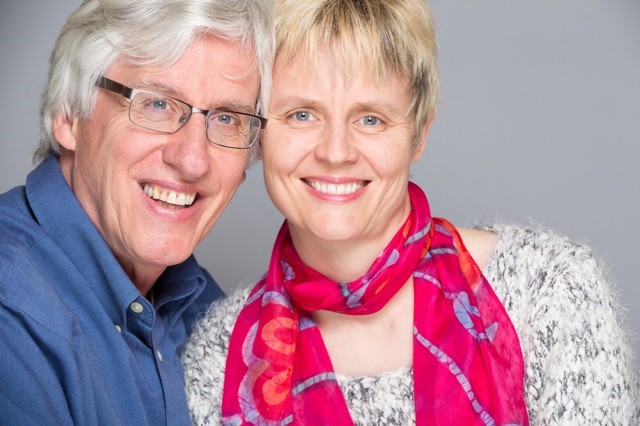The chair across sits vacant
but your voice has not left me
while I write, you visit me
as I work, you read along
you still speak your wisdom
not only in remembered dialogues
but in this poetic living
where stories are the
gossamer and sinew threads
on which we stake futures
Last June, when Nancy Arthur approached me to write a chapter in Career Theories and Models at Work: Ideas for Practice, I told her our sad news. My life and work partner, Frans Meijers – well known in The Netherlands and internationally for his work in career research and career identity theory – was diagnosed with terminal cancer. We went from living a vibrant, inspired life of writing, research and teaching to preparing for his death.
Many colleagues and friends visited and wrote us in those final months. Frans and I spoke openly about everything – we grieved together and we lived moment by moment, engaged in a very precious conversation about life, love and meaning-making. Our work did not end when his illness began. If anything, the usefulness of how we encourage(d) others to make meaning through our narrative method, Career Writing, became even more apparent.
What we saw in the process of Frans’ illness is that our rich learning on how to develop a career identity also applied to the reality of living while dying. Making meaning through narrative serves us in developing “the warm inner compass” regardless of the context of our challenge. We knew how to live well and identify our new direction even in the wake of this; we had practiced year in and year out. The way in which we had engaged with narrative and dialogical learning in our career’s work was exactly the poetic creativity needed to face this double loss: Frans’ life and our life together.
Now, several months after Frans’ death, I continue to move through life and grief with the same attention and a deeply anchored capacity for thriving. I welcome every feeling – even the ones that people tend to label as ‘negative’ and that tend to trigger resistance in us. I welcome the thoughts, doubts and stories that offer themselves to my imagination, though I need not believe any or all of them. And I continue to put the words on the page and dialogue with Frans.
Uncovering a new narrative
The model of self that underlies our work, based on Hubert Hermans’ Dialogical Self Theory, shows how we are indeed a dynamic and diverse multi-voiced self. Others are as much internalized voices speaking to us as the voices we would naturally consider our own. The idea is to observe and allow more selves to speak and inspire us than the ones that usually dominate our internal landscape.
The model also shows how creative, expressive and reflective writing exercises move us from an unhelpful story to a new story – this is also covered in the book chapter. Our learning frequently begins with a “boundary experience”: a life challenge for which we have not yet developed sufficient ways to respond. Our first story is marked by a sense of stuckness and suffering. We feel victimized and fearful; we may even reach around ourselves in blame or in a longing to be rescued from our fate. By simply recognizing our stuckness and by inviting ourselves into articulating our conflicting feelings, we take a small step out of the first story and toward a second – a new narrative. Of course, we do not do this alone when we set out writing – a facilitator of Career Writing (often in a group setting) reflects back to us what they are hearing so our own capacities for noticing are strengthened and we have ‘safe space’ in which to work. In the chapter we contributed, Charlene Bonnar uncovers her internalized story about First Nations and how a shift in the story might help her better serve her Indigenous students. “In order to truly connect and make a difference in the lives of Indigenous students, I had to examine my own education and preconceptions. I needed to write my first story about my childhood and adolescence on the Canadian prairies and the story of the racist and colonial upbringing that was part of it.” (Career Theories, p 188.)

Applying our own writing wisdom
In the days and weeks that followed Frans’ diagnosis, we got up each morning and walked around the nearby pond. After our walk we would come home to write. We used a method called Proprioceptive Writing, developed by author Linda Trichter-Metcalf. In this writing method, a person writes to music, listening to what is being said within while simultaneously paying attention to what they are writing on the page. Next, they ask the Proprioceptive Question, which is “What do I mean by …?” For instance, “
What do I mean by fearful of death …?” “losing him …?” “… illness is like a thief of our lives?”
In the seven months before Frans’ death in November, I also wrote a series of poems to make meaning out of this unexpected turn of events and I shared many of those poems with Frans. They helped us to stay in touch with our feelings and to speak about what was important to us. Our dialogues also made it possible to speak about Frans’ end-of-life choices and the future I would be going into without him. What seemed to impress some of our visitors is that we could speak of the vicissitudes of illness, while remaining open, optimistic and deeply grateful. No topic was taboo and each day was lived in appreciation of the present moment. This was no small feat for two career academics with customarily busy schedules, used to focusing on future projects. We were now occupying a few square metres of our home for the greater part of our days, serving tea and coffee to our guests.
Frans would sometimes say, “Except for the fact that I’m dying, I have nothing to complain about.” This was a source of laughter for those visiting and remembering that now, I smile and want to ask him what he might like to add to this blog.
Frans: This process is about developing a second story, by sensing, sifting, focusing and understanding – the stages Bill Law described long ago, based on the work of Piaget. It is an ongoing learning process, not a destination.
Reinekke: And … anything else?
Frans: To enjoy. To work hard, but to also enjoy the creativity of the process. Identity learning – this developing of career agency through imaginative work – this learning about ourselves is hard work, even painful at times, but it opens whole worlds, as it did for me.
Even those we have lost continue to contribute to how we make meaning of lived experience. We can look at the empty chair and grieve and at the same time we can see the empty chair and continue the conversation. This is one of the gifts of poetic creativity.




